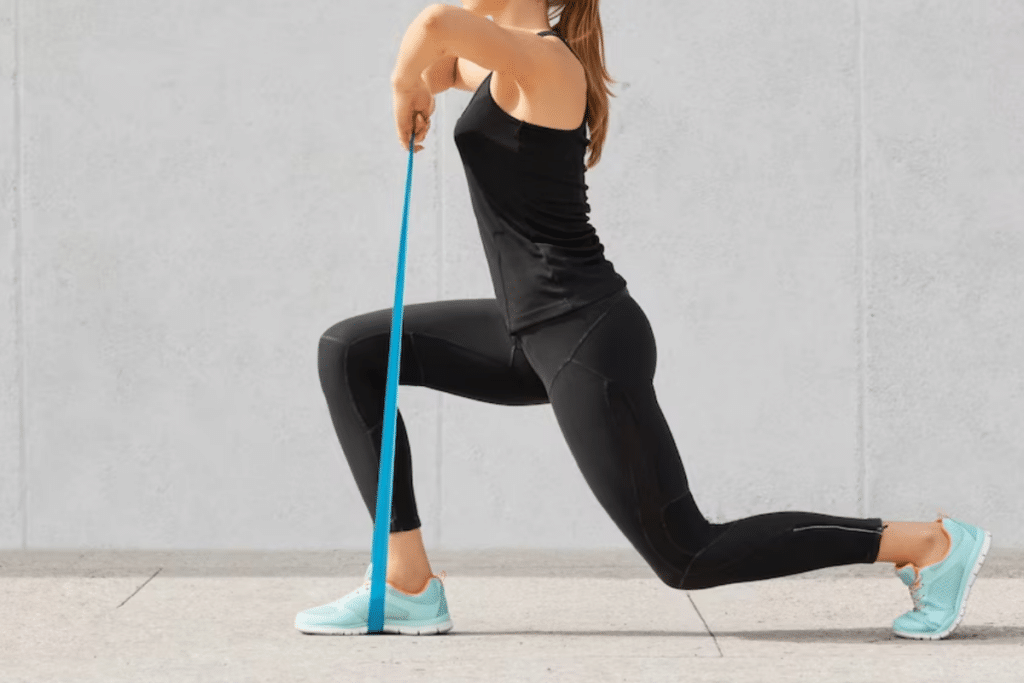Resistance band lunges are an effective lower-body exercise that can help you build strength, tone your muscles, and improve your balance. While traditional lunges are a popular exercise, adding resistance bands can increase the intensity and provide a greater challenge to your muscles.
In this article
- 3 Ways to Do Lunges with a Resistance Band
- What are the benefits of resistance band lunges?
- What should you consider when choosing resistance bands?
- How many reps, sets, and frequencies for resistance band lunges?
- Alternatives to resistance band lunges without a band?
- When will resistance band lunges show results and how to track progress?
- Frequently Asked Questions (FAQ)
- Final Word

Resistance band lunges can target multiple muscle groups, including your quadriceps, hamstrings, glutes, and calves, all while improving your overall stability and mobility. In this comprehensive guide, we will walk you through the proper form and technique for resistance band lunges, provide modifications and progressions, and answer common questions about the exercise.
3 Ways to Do Lunges with a Resistance Band
1. Standard lunges
You can do standard lunges by stepping on the band with one foot, stepping backward with the other foot, grabbing the band with both hands, bending your front knee, going down until you touch the ground with your back knee, and then exploding back up.
Check out this video called ” How To Do Lunges With Resistance Bands” from the Back In Shape Program youtube channel.
2. Resistance band lunge with knee drive
In this variation, you anchor the band to a rig or pole, step into the loop and face away from the anchor. Step away from the rig to provide tension to the band. Stand with your feet shoulder-width apart and your chest high. From here, take a large step and perform a lunge. As you return from the lunge, drive the knee of the lunging leg upward.
Check out this video called “Resistance Band Lunge to Knee Drive” from the Sayaw Limited youtube channel.
3. Resistance band reverse lunges
For this exercise, grip a light to medium weight (like a kettlebell, dumbbell, or plate) with both hands and hold it at chest level. Step back so that the band pulls straight.
Check out this video called “Resistance band reverse lunges” from the BluePhoenix Fitness youtube channel.
What are the benefits of resistance band lunges?
Let’s explore the advantages of resistance band lunges for enhancing fitness and overall well-being.
1. Improved Balance and Coordination
Lunges are classified as a unilateral exercise because they work one side of the body at a time. This can improve your balance and coordination.
2. Weight Loss
Lunges work the large muscle groups in your lower body, which builds lean muscle and reduces body fat. This can increase your resting metabolism, thus assisting in weight loss.
[Related: 5 Tricep Exercises with Resistance Bands for Strong Arms]
3. Decreased Risk of Injury
Resistance band lunges can help decrease the risk of injury by improving muscle balance around your joints.
4. Muscle Targeting
Resistance band lunges are great for targeting the gluteus maximus, one of the largest muscles in the body. When performed correctly, they can effectively strengthen the gluteus maximus and surrounding muscles
What should you consider when choosing resistance bands?
When selecting the right resistance band for lunges, several factors should be considered. Firstly, consider your fitness level, as using a band that’s too challenging may compromise your form and lead to injury. A light or medium resistance band may be appropriate for beginners or those new to resistance training. More advanced users may benefit from heavier resistance bands to challenge and build muscle.

Additionally, consider the type of resistance band, such as loop bands, tube bands, and figure-eight bands, and choose the one that suits your preference and comfort level. Popular brands like TheraBand, Fit Simplify, and Tribe Fitness offer various resistance levels and band types to choose from.
How many reps, sets, and frequencies for resistance band lunges?
The ideal number of reps and sets for resistance band lunges depends on your fitness level, goals, and experience. Beginners may start with 2-3 sets of 8-10 reps per leg, while more advanced users can increase to 3-4 sets of 12-15 reps per leg. Aim to perform resistance band lunges 2-3 times per week, allowing sufficient rest between sessions to promote muscle recovery. As you progress, gradually increase the number of sets, reps, and resistance levels to keep challenging the muscles.
Alternatives to resistance band lunges without a band?
Resistance band lunges can be performed without a band by using dumbbells, kettlebells, or body weights. Adding weights to the lunges can increase resistance and challenge the muscles further. For instance, holding a dumbbell or kettlebell in each hand during lunges can provide an extra challenge to the glutes, hamstrings, and quads.
Walking lunges, reverse lunges, and lateral lunges are also good alternatives to resistance band lunges that offer similar benefits and engage different muscle groups.
When will resistance band lunges show results and how to track progress?
Generally, regular practice of resistance band lunges can lead to improvements in muscle tone, strength, and balance within a few weeks. To track progress, consider taking measurements, progress photos, or keeping a workout journal to note improvements in form, performance, and resistance levels over time. Additionally, it’s essential to maintain a healthy diet and lifestyle to maximize the benefits of resistance band lunges.
Frequently Asked Questions (FAQ)
Got more questions about resistance band lunges? Check out some of the most commonly asked questions about this topic below.
What are some common mistakes to avoid when doing resistance band lunges?
Some common mistakes to avoid when doing resistance band lunges include allowing your front knee to extend past your toes, arching your back, and leaning too far forward. Make sure to keep your core engaged, and your upper body stable, and maintain proper form throughout the exercise.
How do I make resistance band lunges easier or harder?
To make resistance band lunges easier, you can use a lighter resistance band or perform the exercise without a band. To make the exercise harder, you can use a heavier resistance band or add more reps and sets. You can also try more advanced variations of the exercise, such as reverse lunges or curtsy lunges.
What muscles do resistance band lunges target?
Resistance band lunges target multiple muscle groups, including your quadriceps, hamstrings, glutes, and calves. They also engage your core and promote overall stability and mobility. To maximize the benefits, focus on proper form and technique and gradually increase the intensity over time.
Final Word
Now that you know how to do resistance band lunges properly, the next step is to incorporate them into your workout routine and start reaping the benefits. So, what are you waiting for? Give resistance band lunges a try and let us know how it goes.
Have you tried resistance band lunges before? What tips or tricks have worked for you? Share your experiences in the comments below. And don’t forget, if you found this article helpful, share it with a friend, and check out my full blog for more tips on health and fitness.
